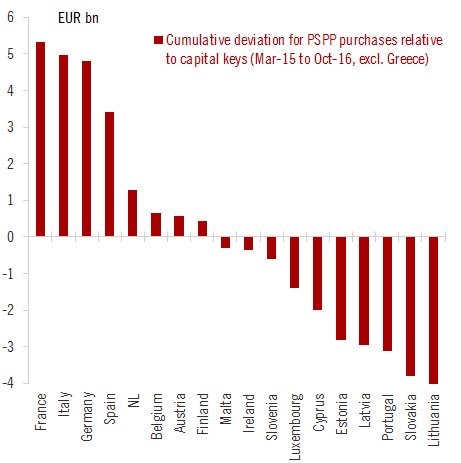The asset purchase program introduced by the European Central Bank (ECB) back in 2015 and extended earlier this year is about to end in March next year. The central bank is currently purchasing €80 billion worth of bonds per month and it is widely expected that over the next meetings, the central bank would announce an extension to the program. Yet some analysts remain skeptical of such a move as the current purchase rate is already posing concerns in some of the bond markets as ECB is failing to meet the key capital ratio.
The key capital ratio is the ratio of monetary equity each National Central Bank hold with the European Central Bank. For example, German Bundes bank holds 18 percent of the total capital at the ECB, Banque de France’s share is 14.2 percent. According to the rules, the ECB would purchase bonds from all across the Eurozone in accordance to the capital subscription ratio or the key capital ratio.
However, the shortage of eligible bonds has already forced the European Central bank to deviate from this target. The above chart shows that this deviation runs in billions of dollar. For example, the European Central Bank (ECB) has bought more than €5 billion worth of bonds in excess of the capital subscription target for France; similarly a €13 billion cumulative deviation for Italy, Germany, and Spain. It has under purchased bonds of smaller countries like Lithuania, Slovakia, Portugal, and more.
If scarcity is a critical issue, the ECB would have to change some rules for these smaller countries before it promises more asset purchases or the deviation would worsen further.



 BOJ’s Noguchi Calls for Cautious, Gradual Interest Rate Hikes to Sustain Inflation Goals
BOJ’s Noguchi Calls for Cautious, Gradual Interest Rate Hikes to Sustain Inflation Goals  FOMC Minutes Expected to Reveal Deep Policy Divide as Markets Eye December Rate Cut
FOMC Minutes Expected to Reveal Deep Policy Divide as Markets Eye December Rate Cut  RBNZ Cuts Interest Rates Again as Inflation Cools and Recovery Remains Fragile
RBNZ Cuts Interest Rates Again as Inflation Cools and Recovery Remains Fragile  Best Gold Stocks to Buy Now: AABB, GOLD, GDX
Best Gold Stocks to Buy Now: AABB, GOLD, GDX  Brazil Central Bank Plans $2 Billion Dollar Auctions to Support FX Liquidity
Brazil Central Bank Plans $2 Billion Dollar Auctions to Support FX Liquidity  Kazakhstan Central Bank Holds Interest Rate at 18% as Inflation Pressures Persist
Kazakhstan Central Bank Holds Interest Rate at 18% as Inflation Pressures Persist  BOJ Signals Possible December Rate Hike as Yen Weakness Raises Inflation Risks
BOJ Signals Possible December Rate Hike as Yen Weakness Raises Inflation Risks  Fed Officials Split as Powell Weighs December Interest Rate Cut
Fed Officials Split as Powell Weighs December Interest Rate Cut 




























